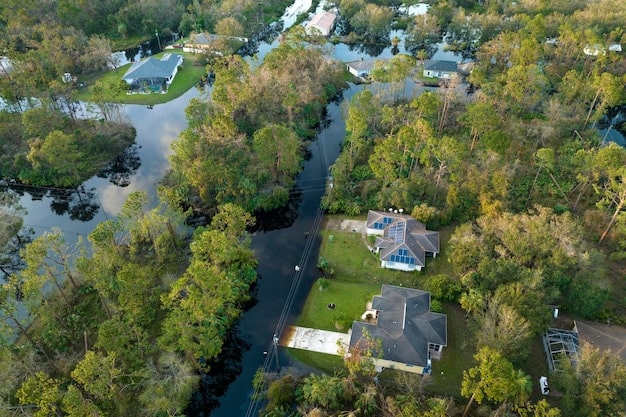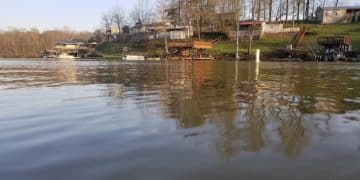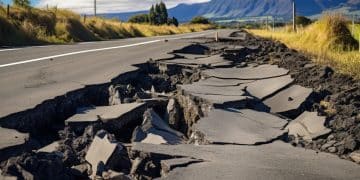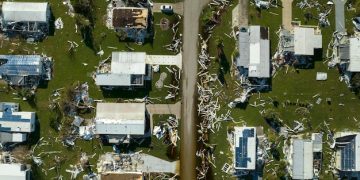Flood Safety: Essential Tips for US Residents in High-Risk Areas

Flood safety is paramount for US residents in high-risk areas, requiring preparedness, awareness, and proactive measures to protect lives and property from the devastating impacts of floods.
Living in a flood-prone area in the United States requires a heightened sense of awareness and preparedness. With the increasing frequency and intensity of floods, understanding and implementing effective flood safety measures is more critical than ever for US residents living in high-risk areas.
Understanding Flood Risks in the US
Flooding is a common natural disaster in the United States, affecting millions of people each year. Understanding the specific flood risks in your area is the first step towards ensuring your safety and protecting your property.
Different regions of the US face varying types of flood risks, from coastal flooding due to hurricanes and storm surges to inland flooding caused by heavy rainfall and overflowing rivers. Each type of flood presents unique challenges and requires specific preparedness measures.
Common Types of Floods in the US
The United States experiences a wide range of flood types, each with its own causes and characteristics. Here are some of the most common:
- Coastal Flooding: Often caused by hurricanes, storm surges, and high tides, coastal flooding can inundate low-lying areas and cause significant damage to coastal communities.
- River Flooding: Occurs when rivers overflow their banks due to heavy rainfall, snowmelt, or dam failures. River flooding can affect large areas along the river’s course.
- Flash Floods: Characterized by their sudden and intense nature, flash floods are typically caused by heavy rainfall over a short period of time. They can occur in any location and pose a significant threat to life and property.
- Urban Flooding: Results from inadequate drainage systems in urban areas that cannot handle heavy rainfall. Urban flooding can cause widespread damage to buildings, roads, and infrastructure.

Identifying the specific flood risks in your area involves researching historical flood data, consulting with local emergency management agencies, and understanding the topography and drainage patterns of your community. This knowledge will help you tailor your flood safety plan to address the specific threats you face.
Understanding the types of floods common in your area helps residents better prepare and respond effectively, mitigating potential damages. Identifying these hazards enables focused safety measures.
Assessing Your Property’s Flood Vulnerability
Once you understand the general flood risks in your area, it’s important to assess your property’s specific vulnerability. This involves evaluating factors such as elevation, proximity to waterways, and the effectiveness of existing flood control measures.
Taking steps to reduce your property’s flood vulnerability can significantly minimize the potential for damage and protect your investment. This may include elevating your home, installing flood barriers, and improving drainage around your property.
Key Factors in Assessing Flood Vulnerability
Several factors contribute to a property’s vulnerability to flooding. Consider the following when assessing your risk:
- Elevation: Properties located at lower elevations are more susceptible to flooding than those at higher elevations.
- Proximity to Waterways: Homes near rivers, streams, and coastlines are at greater risk of flooding.
- Drainage: Poor drainage systems can exacerbate flooding by allowing water to accumulate around your property.
- Flood Control Measures: The presence of levees, dams, and other flood control structures can reduce the risk of flooding, but they are not foolproof.
By thoroughly assessing your property’s flood vulnerability, you can identify specific weaknesses and take proactive steps to address them. This will help you protect your home and family from the devastating impacts of floods.
Understanding these vulnerabilities enables more effective safety precautions, promoting a safer living environment during floods.

Creating a Family Flood Safety Plan
A well-prepared family flood safety plan is essential for protecting your loved ones during a flood. This plan should include evacuation routes, communication strategies, and emergency supplies.
Practice your flood safety plan regularly with your family to ensure everyone knows what to do in the event of a flood. This will help reduce panic and ensure a coordinated response.
Essential Elements of a Family Flood Safety Plan
A comprehensive family flood safety plan should include the following elements:
- Evacuation Routes: Identify multiple evacuation routes from your home to higher ground, taking into account potential road closures and flood zones.
- Communication Plan: Establish a communication plan to ensure family members can stay in touch during a flood. This may include designating a common meeting point and using a texting app.
- Emergency Supplies: Assemble a flood safety kit with essential supplies such as food, water, medications, and a first-aid kit.
Creating and practicing a family flood safety plan is a crucial step in protecting your loved ones during a flood. By preparing in advance, you can increase your chances of staying safe and minimizing the impact of the disaster.
Proactive planning significantly boosts safety outcomes, equipping families with the knowledge and resources to navigate flood emergencies effectively.
Protecting Your Home from Flood Damage
Taking steps to protect your home from flood damage can significantly reduce the financial and emotional toll of a flood. This may involve structural modifications, floodproofing measures, and insurance coverage.
Investing in flood protection measures is a wise decision for homeowners in high-risk areas. While these measures may require an initial investment, they can save you significant money and stress in the long run.
Effective Home Flood Protection Measures
Consider the following measures to protect your home from flood damage:
- Elevate Your Home: Raising your home above the base flood elevation can prevent floodwaters from entering the living space.
- Install Flood Barriers: Flood barriers, such as sandbags or flood walls, can help redirect floodwaters away from your home.
- Improve Drainage: Improving drainage around your property can help prevent water from accumulating and causing damage.
Protecting your home from flood damage is a proactive investment that can provide peace of mind and financial security. By implementing these measures, you can significantly reduce the risk of flood-related losses and safeguard your property.
Implementing precautions minimizes potential harm, preserving both property value and emotional well-being during flood events.
Staying Informed During a Flood Emergency
Access to accurate and timely information is critical during a flood emergency. This includes monitoring weather forecasts, heeding evacuation orders, and staying informed about road closures and shelter locations.
Utilize reliable sources of information, such as the National Weather Service and local emergency management agencies, to stay informed during a flood emergency. Avoid spreading rumors or misinformation, which can cause confusion and panic.
Reliable Sources of Flood Emergency Information
Rely on the following sources for accurate and up-to-date flood emergency information:
- National Weather Service: Provides weather forecasts, flood warnings, and other critical information.
- Local Emergency Management Agencies: Offer local updates, evacuation orders, and shelter information.
- News Media: Provides coverage of flood events and emergency response efforts.
Staying informed during a flood emergency can help you make informed decisions and take appropriate actions to protect yourself and your family. Remember to trust only credible sources of information and avoid spreading unverified reports.
Timely information empowers effective responses, guiding individuals to secure safety and make well-informed choices in crisis situations.
Recovering After a Flood
The recovery process after a flood can be challenging, but it’s important to take steps to ensure your safety and begin rebuilding your life. This includes assessing damage, filing insurance claims, and seeking assistance from disaster relief organizations.
Be patient and persistent during the recovery process. It may take time to restore your home and community, but with the support of family, friends, and disaster relief organizations, you can overcome the challenges and rebuild your life.
Key Steps in Flood Recovery
Follow these steps to navigate the flood recovery process:
- Assess Damage: Document the extent of the flood damage to your property, including photos and videos.
- File Insurance Claims: Contact your insurance company to file a claim for flood-related losses.
- Seek Assistance: Reach out to disaster relief organizations for assistance with food, shelter, and other essential needs.
Recovering from a flood requires resilience, determination, and the support of others. By taking these steps and seeking assistance when needed, you can begin the healing process and rebuild your life after a flood.
Strategic recovery efforts are crucial for resuming normality, addressing damages, and fostering resilience within devastated communities.
| Key Point | Brief Description |
|---|---|
| ⚠️ Understand Flood Risks | Know the types of floods common in your area to prepare effectively. |
| 🏠 Assess Home Vulnerability | Evaluate your property’s elevation, drainage, and proximity to waterways. |
| 🛡️ Protect Your Home | Elevate your home, install barriers, and improve drainage to minimize damage. |
| 🆘 Family Safety Plan | Create evacuation routes, communication strategies, and emergency supply kits. |
Frequently Asked Questions (FAQs)
▼
Low-lying coastal regions, areas near rivers and streams, and urban locations with poor drainage systems are generally the most susceptible to flooding. Consult local flood maps for specific risks.
▼
Store important documents in waterproof containers and keep them in a safe, elevated location. Consider making digital copies and storing them in a secure cloud storage.
▼
Seek higher ground immediately. Do not attempt to walk or drive through floodwaters. If you are in a vehicle, abandon it and move to higher ground if it is safe to do so.
▼
Yes, flood insurance is recommended for all homeowners, regardless of their location. Flooding can occur anywhere, and standard homeowner’s insurance policies typically do not cover flood damage.
▼
Sign up for alerts from the National Weather Service and your local emergency management agency. Monitor local news broadcasts and social media channels for updates on flood warnings and evacuation orders.
Conclusion
Ensuring flood safety for US residents in high-risk areas requires a comprehensive approach that includes understanding local risks, assessing property vulnerability, creating a family safety plan, and staying informed during emergencies. By taking proactive measures, individuals and communities can significantly reduce the impact of floods and protect lives and property.





